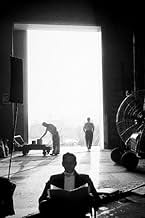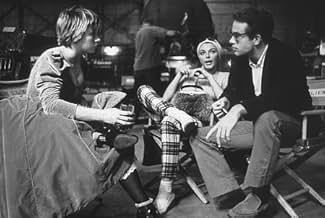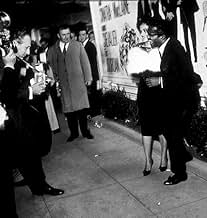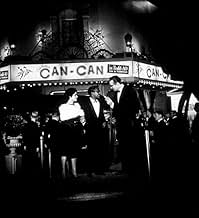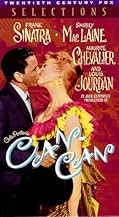IMDb रेटिंग
6.3/10
2.6 हज़ार
आपकी रेटिंग
अपनी भाषा में प्लॉट जोड़ेंIn 1896 Paris, a female nightclub proprietor fights against the forces of public morality for the right to feature her performers doing the risqué dance, the Can-Can.In 1896 Paris, a female nightclub proprietor fights against the forces of public morality for the right to feature her performers doing the risqué dance, the Can-Can.In 1896 Paris, a female nightclub proprietor fights against the forces of public morality for the right to feature her performers doing the risqué dance, the Can-Can.
- 2 ऑस्कर के लिए नामांकित
- 5 जीत और कुल 7 नामांकन
Frank Baker
- Party Guest
- (बिना क्रेडिट के)
Benjie Bancroft
- Club Patron
- (बिना क्रेडिट के)
Herman Belmonte
- Waiter
- (बिना क्रेडिट के)
Shirley Blackwell
- Townsfolk
- (बिना क्रेडिट के)
Eugene Borden
- Police Officer Chevrolet
- (बिना क्रेडिट के)
Buddy Bryan
- Dancer
- (बिना क्रेडिट के)
Carole Bryan
- Gigi
- (बिना क्रेडिट के)
कहानी
क्या आपको पता है
- ट्रिवियाIt is explained in the film that the can-can was considered a lewd and lascivious dance (in reality often performed without panties).
- गूफ़About 34 minutes in, when Philipe tries to close the window in Simone's boudoir, the whole wall shakes as he struggles with the window, indicating that it is a set wall and not a real building.
- भाव
François Durnais: You look like a broken umbrella.
- क्रेज़ी क्रेडिटOpening credits prologue: Montmartre-1896
- कनेक्शनFeatured in 20th Century-Fox: The First 50 Years (1997)
- साउंडट्रैकI Love Paris
(uncredited)
Music by Cole Porter
Lyrics by Cole Porter
Sung by chorus over the beginning and end credits
फीचर्ड रिव्यू
This is another film which was often shown on TV (twice on the local channel alone!) but I hadn’t bothered with until now; it’s recently been released as a 2-Disc Set by Fox but, in view of its middling reputation, opted to acquire the film by itself.
To begin with, the DVD presentation had its good and bad points: the film was made available in its “Roadshow Version” – running 142 minutes against the “General Release Version” which eliminated 11 minutes of extraneous music (Overture, Intermission, Entr’ Acte and Exit Music); unfortunately, time seems to have taken its toll on the negative as there were several instances of color fluctuation throughout! As can be surmised, I decided to give the film a whirl as part of my ongoing marathon to commemorate the 10th anniversary from the passing of its male lead – Frank Sinatra; curiously enough, given his reputation as one of the foremost American singers, he appeared in few vintage musicals over the years…and it’s certainly a tribute to his acting talent that his non-musical work (often in hard-hitting, even groundbreaking films) has tended to overshadow this more familiar aspect of his personality – at least on the silver screen!
Anyway, to get back to the film proper: I found it quite engaging and its considerable length not overly taxing – and this, to a large degree, is thanks to the formidable star cast (which, apart from Sinatra, included Shirley MacLaine, Maurice Chevalier and Louis Jourdan). The first two had already appeared together – albeit in dramatic roles – in SOME CAME RUNNING (1958), while the others had been wonderfully teamed in the same genre and a similar ambiance in GIGI (1958). Ironically, both these films were helmed by a master stylist – Vincente Minnelli…so, perhaps, Fox should have struck a deal with MGM to acquire his services for CAN-CAN – but, given director Lang’s previous musical success with THE KING AND I (1956), they obviously thought he could do no wrong. The fact is that his handling is sterile and more accommodating to the Widescreen ratio than the necessities of the plot and characters – filming events from a distance and rarely cutting or even moving the camera; this lazy approach (which still landed him a nomination from the Directors' Guild Of America!) is doubly frustrating when viewed on a small screen!!
Apparently, the production went through a lot of script changes (Sinatra’s role, reportedly, wasn’t even in the stage original to begin with!), songs were dropped and replaced by other Cole Porter standards which don’t really fit in (such as Jourdan’s “You Do Something To Me”); the rest of the soundtrack isn’t particularly outstanding (unlike that of GIGI, for instance) but a number of tunes are cleverly reprised (sometimes with variations and by different characters) during the course of the film. It was nice, too, seeing two world-renowned singers with such different styles as Sinatra and Chevalier come together (and having fun with it); Chevalier and Jourdan’s roles, then, are virtual carbon copies of their GIGI characterizations – but it’s a formula that seems to work (even if it’s not as central to the main plot this time around, Jourdan having been relegated to The Other Man type).
MacLaine did few musicals as well but her vivaciousness (as a dancer and owner of an establishment which finds itself frequently in trouble with the law over the forbidden “Can-Can” dance, but who manages to charm the stuffy judge at the trial) ensures that her numbers emerge as the show’s highlights: the Apache Dance, the drunken recital of a vulgar song at her engagement party to Jourdan (at the instigation of lawyer Sinatra, who loves her but is unwilling to commit himself) and the “Garden Of Eden” sequence (intended to demonstrate that “Sin wasn’t invented in Montmartre – it was only perfected there”!). Two other important figures (though both severely underwritten) are those played by Juliet Prowse and Frenchman Marcel Dalio as the nervous but devoted manager of the “Bal De Paradis” (the latter was a versatile actor in his native land, but he was stuck with this kind of unrewarding role during his long tenure in Hollywood!); the former appears as a leading dancer at the club and MacLaine’s prospective rival – interestingly, the two actresses’ physiognomies are strikingly similar – for Sinatra’s attentions (a situation which is indirectly played upon during the afore-mentioned “Garden Of Eden” number, apart from which they’re teamed for the climactic Can-Can performance…to the predictable enthusiasm of the formerly disapproving head of a female Legion Of Decency-type group).
In the end, while this film can’t be considered a classic musical as such, it still seems to me to have been unfairly maligned – as some fantastic talent has been assembled in the service of a charming (albeit unsurprising) narrative to provide colorful (if uninspired) entertainment which the genre was capable of during its studio-system heyday…
To begin with, the DVD presentation had its good and bad points: the film was made available in its “Roadshow Version” – running 142 minutes against the “General Release Version” which eliminated 11 minutes of extraneous music (Overture, Intermission, Entr’ Acte and Exit Music); unfortunately, time seems to have taken its toll on the negative as there were several instances of color fluctuation throughout! As can be surmised, I decided to give the film a whirl as part of my ongoing marathon to commemorate the 10th anniversary from the passing of its male lead – Frank Sinatra; curiously enough, given his reputation as one of the foremost American singers, he appeared in few vintage musicals over the years…and it’s certainly a tribute to his acting talent that his non-musical work (often in hard-hitting, even groundbreaking films) has tended to overshadow this more familiar aspect of his personality – at least on the silver screen!
Anyway, to get back to the film proper: I found it quite engaging and its considerable length not overly taxing – and this, to a large degree, is thanks to the formidable star cast (which, apart from Sinatra, included Shirley MacLaine, Maurice Chevalier and Louis Jourdan). The first two had already appeared together – albeit in dramatic roles – in SOME CAME RUNNING (1958), while the others had been wonderfully teamed in the same genre and a similar ambiance in GIGI (1958). Ironically, both these films were helmed by a master stylist – Vincente Minnelli…so, perhaps, Fox should have struck a deal with MGM to acquire his services for CAN-CAN – but, given director Lang’s previous musical success with THE KING AND I (1956), they obviously thought he could do no wrong. The fact is that his handling is sterile and more accommodating to the Widescreen ratio than the necessities of the plot and characters – filming events from a distance and rarely cutting or even moving the camera; this lazy approach (which still landed him a nomination from the Directors' Guild Of America!) is doubly frustrating when viewed on a small screen!!
Apparently, the production went through a lot of script changes (Sinatra’s role, reportedly, wasn’t even in the stage original to begin with!), songs were dropped and replaced by other Cole Porter standards which don’t really fit in (such as Jourdan’s “You Do Something To Me”); the rest of the soundtrack isn’t particularly outstanding (unlike that of GIGI, for instance) but a number of tunes are cleverly reprised (sometimes with variations and by different characters) during the course of the film. It was nice, too, seeing two world-renowned singers with such different styles as Sinatra and Chevalier come together (and having fun with it); Chevalier and Jourdan’s roles, then, are virtual carbon copies of their GIGI characterizations – but it’s a formula that seems to work (even if it’s not as central to the main plot this time around, Jourdan having been relegated to The Other Man type).
MacLaine did few musicals as well but her vivaciousness (as a dancer and owner of an establishment which finds itself frequently in trouble with the law over the forbidden “Can-Can” dance, but who manages to charm the stuffy judge at the trial) ensures that her numbers emerge as the show’s highlights: the Apache Dance, the drunken recital of a vulgar song at her engagement party to Jourdan (at the instigation of lawyer Sinatra, who loves her but is unwilling to commit himself) and the “Garden Of Eden” sequence (intended to demonstrate that “Sin wasn’t invented in Montmartre – it was only perfected there”!). Two other important figures (though both severely underwritten) are those played by Juliet Prowse and Frenchman Marcel Dalio as the nervous but devoted manager of the “Bal De Paradis” (the latter was a versatile actor in his native land, but he was stuck with this kind of unrewarding role during his long tenure in Hollywood!); the former appears as a leading dancer at the club and MacLaine’s prospective rival – interestingly, the two actresses’ physiognomies are strikingly similar – for Sinatra’s attentions (a situation which is indirectly played upon during the afore-mentioned “Garden Of Eden” number, apart from which they’re teamed for the climactic Can-Can performance…to the predictable enthusiasm of the formerly disapproving head of a female Legion Of Decency-type group).
In the end, while this film can’t be considered a classic musical as such, it still seems to me to have been unfairly maligned – as some fantastic talent has been assembled in the service of a charming (albeit unsurprising) narrative to provide colorful (if uninspired) entertainment which the genre was capable of during its studio-system heyday…
- Bunuel1976
- 18 मई 2008
- परमालिंक
टॉप पसंद
रेटिंग देने के लिए साइन-इन करें और वैयक्तिकृत सुझावों के लिए वॉचलिस्ट करें
- How long is Can-Can?Alexa द्वारा संचालित
विवरण
- रिलीज़ की तारीख़
- कंट्री ऑफ़ ओरिजिन
- आधिकारिक साइट
- भाषाएं
- इस रूप में भी जाना जाता है
- Jack Cummings' Production of Cole Porter's Can-Can
- फ़िल्माने की जगहें
- पेरिस, फ़्रांस(stock footage of the evening barge sequences)
- उत्पादन कंपनी
- IMDbPro पर और कंपनी क्रेडिट देखें
बॉक्स ऑफ़िस
- बजट
- $60,00,000(अनुमानित)
- चलने की अवधि2 घंटे 11 मिनट
- पक्ष अनुपात
- 2.20 : 1
इस पेज में योगदान दें
किसी बदलाव का सुझाव दें या अनुपलब्ध कॉन्टेंट जोड़ें





